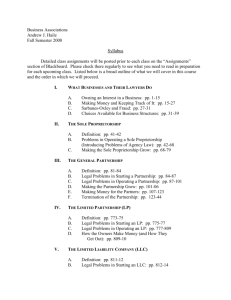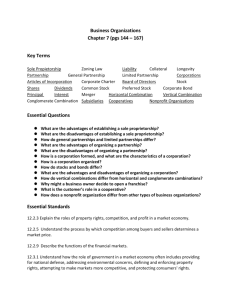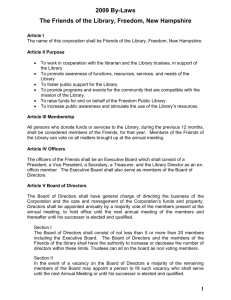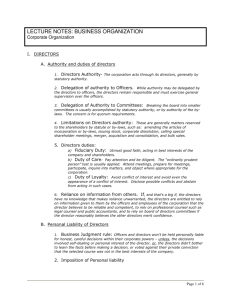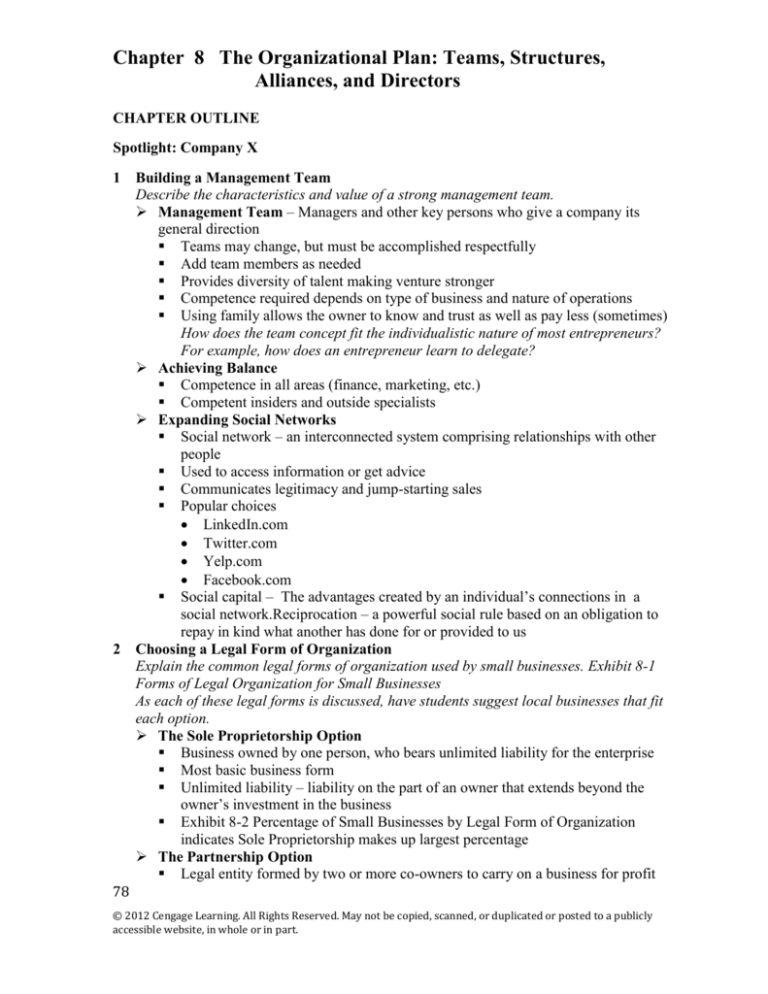
Chapter 8 The Organizational Plan: Teams, Structures,
Alliances, and Directors
CHAPTER OUTLINE
Spotlight: Company X
1 Building a Management Team
Describe the characteristics and value of a strong management team.
Management Team – Managers and other key persons who give a company its
general direction
Teams may change, but must be accomplished respectfully
Add team members as needed
Provides diversity of talent making venture stronger
Competence required depends on type of business and nature of operations
Using family allows the owner to know and trust as well as pay less (sometimes)
How does the team concept fit the individualistic nature of most entrepreneurs?
For example, how does an entrepreneur learn to delegate?
Achieving Balance
Competence in all areas (finance, marketing, etc.)
Competent insiders and outside specialists
Expanding Social Networks
Social network – an interconnected system comprising relationships with other
people
Used to access information or get advice
Communicates legitimacy and jump-starting sales
Popular choices
LinkedIn.com
Twitter.com
Yelp.com
Facebook.com
Social capital – The advantages created by an individual’s connections in a
social network.Reciprocation – a powerful social rule based on an obligation to
repay in kind what another has done for or provided to us
2 Choosing a Legal Form of Organization
Explain the common legal forms of organization used by small businesses. Exhibit 8-1
Forms of Legal Organization for Small Businesses
As each of these legal forms is discussed, have students suggest local businesses that fit
each option.
The Sole Proprietorship Option
Business owned by one person, who bears unlimited liability for the enterprise
Most basic business form
Unlimited liability – liability on the part of an owner that extends beyond the
owner’s investment in the business
Exhibit 8-2 Percentage of Small Businesses by Legal Form of Organization
indicates Sole Proprietorship makes up largest percentage
The Partnership Option
Legal entity formed by two or more co-owners to carry on a business for profit
78
© 2012 Cengage Learning. All Rights Reserved. May not be copied, scanned, or duplicated or posted to a publicly
accessible website, in whole or in part.
Chapter 8 The Organizational Plan: Teams, Structures,
Alliances, and Directors
Qualifications of Partners
Involves consideration of legal issues as well as personal and managerial
factors
Should be honest, healthy, capable, and compatible
Exhibit 8-3 The Advantages and Disadvantages of Partnerships
Suggestions
Choose your partner carefully
Be open, but cautious, about partnerships with friends
Test-drive the relationship, if possible
Create a combined vision for he business
Prepare for the worst
Rights and Duties of Partners
Partnerships agreement – document that states explicitly the rights and duties
of partners (especially important with family members)
Joint and several liability – liability of each partner resulting from any one
partner’s ability to legally bind the other partners
Termination of a Partnership
Death, incapacity, or withdrawal of a partner ends partnership
Requires liquidation or reorganization of the business
May result in substantial losses to all partners, but may be necessary
The C Corporation Option
Definitions
Corporation – business organization that exists as a legal entity and provides
limited liability to its owners
Legal entity – business organization that is recognized by the law as having a
separate legal existence
C corporation – ordinary corporation, taxed by the federal government as a
separate legal entity
The Corporate Charter
Document that establishes a corporation’s existence
Sometimes called articles of incorporation or certificate of incorporation
Brief, in accord with state law, and broad in its statement of the firm’s powers
Corporate bylaws outline the basic rules for ongoing formalities and decisions
of corporation such as size of board of directors, duties and responsibilities of
directors and officers, scheduling meetings of directors and shareholders, etc.
Rights and Status of Stockholders
Ownership evidenced by stock certificates (a document specifying the number
of shares owned by a stockholder)
Pre-emptive right – right of stockholders to buy new shares of stock before
they are offered to the public
Limited Liability of Stockholders- stockholder liability restricted to the amount of
money they invest in the business
Death or Withdrawal of Stockholders – ownership easily transferable
79
© 2012 Cengage Learning. All Rights Reserved. May not be copied, scanned, or duplicated or posted to a publicly
accessible website, in whole or in part.
Chapter 8 The Organizational Plan: Teams, Structures,
Alliances, and Directors
Maintaining Corporate Status
Must hold annual meetings of both the shareholders and the board of directors
Keep minutes to document the major decisions of shareholders and directors
Maintain bank accounts separate from owners’ bank accounts
File separate income tax return for the business
3 Criteria for Choosing an Organizational Form (see Exhibit 8-4 Comparison of Basic
Legal Forms of Organization)
Identify factors to consider in choosing among the primary legal forms of organization
Initial Organizational Requirements and Costs
Liability of Owners
Choosing form for simplicity can cost more than money
Incorporation will not protect a firm’s owners from liability
Piercing the Corporate Veil – situation in which the courts conclude that
incorporation has been used to perpetuate a fraud, skirt a law, or commit some
wrongful act, and thus remove liability protections from the corporate entity
No form of organization can protect from all forms of liability
Most banks and many suppliers will require small business owners to sign a
personal guarantee before loaning money or extending credit regardless of the
form of organization
Continuity of Business
Transferability of Ownership
Management Control
Attractiveness for Raising Capital
Income taxes
Sole proprietorship
Partnership
C Corporation
Have students discuss each of these criteria and indicate which are the most important to
them and tell why they are important.
4 Specialized Forms of Organization
Describe the unique features and restrictions of five specialized organizational forms.
The Limited Partnership – partnership with at least one general partner and one or
more limited partners
General partner – A partner who has unlimited liability and remains personally
liable for debts of the business
Limited partners – A partner who is not active in its management and has limited
personal liability. The S Corporation (Subchapter S Corporation)
Type of corporation that offers limited liability to its owners but is taxed by the
federal government as a partnership
Must meet specific requirements
No more than 100 stockholders allowed
All stockholders must be individuals or certain qualifying estates and trusts
Only one class of stock can be outstanding
Fiscally, the corporation must operate on a calendar-year basis
80
© 2012 Cengage Learning. All Rights Reserved. May not be copied, scanned, or duplicated or posted to a publicly
accessible website, in whole or in part.
Chapter 8 The Organizational Plan: Teams, Structures,
Alliances, and Directors
Shareholders may not include nonresident aliens
The Limited Liability Company
Form of organization in which owners have limited liability buy pay personal
income taxes on business profits
Major advantage is the liability protection
Usually the best choice for new businesses
Ability to pass taxable income on to shareholders
Easier to set up
More flexible
Significant tax advantages
Better to us a C corporation if you want to:
Provide extensive fringe benefits to owners or employees
Offer stock options to employees
Go public or sell out at some time in the future
Eventually convert to a C corporation
The Professional Corporation
Form of corporation that shields owners from liability and is set up for individuals
in certain professional practices
Does not protect a practitioner from his/her own negligence or malpractice
Applies to narrow range of enterprises
Many states require this form of organization before a practice can operate
The Nonprofit Corporation
Form of corporation for enterprises established to serve civic, educational,
charitable, or religious purposes but not for generation of profits
Most become 501[c](3) organizations
IRS will not allow this option for an individual or partnership
Organizational test – verification of whether a nonprofit organization is staying
true to its stated purpose
5 Forming Strategic Alliances
Understand the uses of strategic alliances in small businesses.
An organizational relationship that links two or more independent business entities
in a common endeavor
Strategic Alliances with Large Companies
Alliances created with both other large corporations and small businesses
Exhibit 8-6Most Popular Small Business Alliances by Type
Strategic Alliances with Small Companies
Provides mutual competitive strength
Allows them to reach goals that would otherwise be too costly or too difficult for
small businesses to accomplish on their own
Setting Up and Maintaining Successful Strategic Alliances
Challenging to find a suitable partner
Spreads the risk of entering new markets
Helps small players with unattractive balance sheets appear stable to the end
buyer
81
© 2012 Cengage Learning. All Rights Reserved. May not be copied, scanned, or duplicated or posted to a publicly
accessible website, in whole or in part.
Chapter 8 The Organizational Plan: Teams, Structures,
Alliances, and Directors
Steps to help succeed
Establish a healthy network of contacts
Identify and contact individuals within a firm who are accessible
Do your homework, and you will win points just for being prepared
Learn to speak and understand the “language” of your partner
Make sure any alliance offer is clearly a win-win opportunity
Continue to monitor the progress of the alliance to ensure that goals and
expectations are being met, and make changes as they become necessary
6 Making the Most of a Board of Directors
Describe the effective use of boards of directors and advisory councils.
The governing body of a corporation, elected by the stockholders
Contributions of Directors
May help with long term strategic decisions
Reviews major policy decisions
Advises on external business conditions and proper reaction to the business cycle
Provide informal advice on specific problems
Offers access to important personal contacts
Selection of Directors
Firm’s attorney, banker, accountant, local management consultants, and other
business executives available, but lack independence needed to look at firm
critically
Outside directors more objective in decisions and advice
Nature and needs of business help determine qualifications required for directors
Compensation of Directors
Compensation varies greatly
Some pay no fees at all
May be annual retainer, board meeting fees, pay for committee work
Money may not be their primary motivation for serving on the board
An Alternative: An Advisory Council
A group that serves as an alternative to a board of directors, acting only in an
advisory capacity
Qualified outsiders serve
Functions much like board of directors
SOURCES OF VIDEO AND OTHER INSTRUCTIONAL MATERIALS
The SBA at http://www.sba.gov/smallbusinessplanner/index.html offers information
on incorporation and permits and licensing. You can also check your state government
Web site for small business and incorporation information.
ANSWERS TO END-OF-CHAPTER DISCUSSION QUESTIONS
1. Why would investors tend to favor a new business led by a management team
over one headed by a lone entrepreneur? Is this preference justified?
82
© 2012 Cengage Learning. All Rights Reserved. May not be copied, scanned, or duplicated or posted to a publicly
accessible website, in whole or in part.
Chapter 8 The Organizational Plan: Teams, Structures,
Alliances, and Directors
Investors are concerned that management has a blend of important management
skills and that the founder has the ability to perform in a professional way. They
realize that the typical “idea person” who starts a business is deficient in some area
of management. This preference appears justified for most ventures of substantial
size.
2. Discuss the merits of the three most basic legal forms of organization.
Sole proprietorship is the most widely used form of organization. However, the
corporation is the most important form when the volume of business activity is
considered. Why is this true? Most small firms are proprietorships, but most big
firms are corporations. Reasons for dominance of the corporate form among big
firms are the feature of limited liability and the possibility of acquiring large
amounts of capital. The third legal form of organization is the partnership (with
general and limited options), but most entrepreneurs contend that the drawbacks of
this form outweigh its advantages.
3. Does the concept of limited liability apply to a sole proprietorship? Why or why
not?
The concept of limited liability that applies to the corporate form of organization
does not apply to a proprietorship because the business is considered an extension
of the individual and not a separate entity. This means that creditors can take the
owner’s personal assets outside the business if the business fails.
4. Suppose a partnership is set up and operated without a formal partnership
agreement. What problems might arise? Explain.
If articles of partnership are not put in writing, disagreements and
misunderstandings may arise about the respective responsibilities of the partners,
the way in which profits are to be distributed, and many other matters. This can
seriously interfere with the normal profitable operation of the business. By reducing
understandings to written form, partners can minimize misunderstandings,
differences in viewpoints, and overlooked issues.
5. Evaluate the three major forms of organization in terms of management control
by the owner and sharing of the firm’s profits.
In a proprietorship, the owner has complete and absolute control. In a general
partnership, an owner must share control with the other partner or partners, and
each partner generally has the power to make commitments binding on the
partnership. In the corporation, control must be shared with other stockholders. This
may not be a problem, however, if the majority owner controls practically all of the
stock. Indeed, if one owner has as much as 51 percent of the stock, in most states
83
© 2012 Cengage Learning. All Rights Reserved. May not be copied, scanned, or duplicated or posted to a publicly
accessible website, in whole or in part.
Chapter 8 The Organizational Plan: Teams, Structures,
Alliances, and Directors
that owner can name the board of directors. However, the majority stockholder
usually has some concern about, as well as some legal obligations to, minority
stockholders. Hence, dilution of ownership control is a feature of the corporate form
of business organization.
In a sole proprietorship, all profits go to the proprietor. In a partnership, however,
profits are shared equally unless the articles of partnership stipulate an unequal
sharing ratio. In a corporation, profits legally belong to the corporation, but
directors (usually named by the majority stockholder) can declare dividends so that
stockholders get a share of the earned profits.
6. What is an S corporation, and what are its principal advantages?
The S corporation is taxed as a partnership and thus avoids the corporate income
tax. Depending on the circumstances of the corporation and the owners, this can
create significant tax savings. Its use is limited to small firms.
7. Why are strategic alliances helpful to many small businesses? What steps can
an entrepreneur take to create strategic alliances and to prevent their failure?
According to strategic alliance experts, strategic alliances are becoming crucial in
building businesses of all kinds and at an earlier stage than ever before. They can
decrease cycle time by allowing startups to access another firm's resources. Since
an opportunity will often go to the entrepreneur who is fast enough to exploit it,
many now see strategic alliances as an essential part of their plan for growth. Such
partnerships represent one way to cope with the rapid change of today's business
environment.
Two-thirds of all alliances run into serious problems within two years of their
creation, and 70% of them do not survive, which shows that alliances are hard to
manage. Taking some basic steps can help entrepreneurs establish healthy alliances
and reduce the risk of their failure. These are (1) establish a healthy network of
contacts, (2) identify and contact individuals within the firm who are likely to return
your call, (3) outline the partner's continuing financial benefits from the alliance,
(4) show the partner that your firm can deliver value to the alliance across several
fronts, and (5) learn to speak and understand the "language" of your partner.
Despite sound planning and execution, many strategic alliances fail, but some upfront planning can head off unnecessary failures.
8. How might a board of directors be of value to management in a small
corporation? What qualifications are essential for a director? Is ownership of
stock in the firm a prerequisite for being a director?
84
© 2012 Cengage Learning. All Rights Reserved. May not be copied, scanned, or duplicated or posted to a publicly
accessible website, in whole or in part.
Chapter 8 The Organizational Plan: Teams, Structures,
Alliances, and Directors
In the small corporation, a properly selected board of directors can be of real value
to the entrepreneur. The board members can be called on to advise the entrepreneur
on the solution of major problems; that is, they can act as de facto management
consultants. They can also assist with policy formulation and redefinition of
business strategy.
The business owner should select outside board members on the basis of their
interest in and potential contributions to the organization. Many individuals are
potentially good board members, and the best available talent should be selected.
The purchase of stock should not be required, although such an agreement might
make service on the board of directors an attractive proposition for a capable
director.
9. What may account for the failure of most small companies to use boards of
directors as more than rubber stamps? What impact is this likely to have on the
business?
There are no doubt many reasons. Many small business owners have never even
thought about the possibility. Some owners are confident of their own abilities and
see no benefit in having a board. Others have misconceptions concerning difficulty
in attracting board members and levels of compensation. Probably the greatest
reason is lack of assurance that a board would be of real value.
If an entrepreneur uses a board of directors as merely a rubber stamp, his or her
small business stands to lose the insights of directors who can help the entrepreneur
look beyond the next few months to make important, long-term strategic decisions.
A well-selected board of directors can also bring supplementary knowledge and
broad experience to corporate management. By virtue of their backgrounds,
directors can fill gaps in the experience of a management team. The board should
meet regularly to provide maximum assistance to the chief executive. In board
meetings, ideas should be debated, strategies determined, and the pros and cons of
policies explored. In this way, the chief executive is assisted by the experience of
all the board members. Their combined knowledge makes possible more intelligent
decisions on issues crucial to the firm. By utilizing the experience of a board of
directors, the chief executive of a small corporation is in no way giving up active
control of its operations. Instead, by consulting with and seeking the advice of the
board’s members, he or she is simply drawing on a larger pool of business
knowledge. A group will typically make better decisions than will a single
individual working in isolation. An active board of directors serves management
in several important ways: by reviewing major policy decisions, by advising on
external business conditions and on proper reaction to the business cycle, by
providing informal advice from time to time on specific problems that arise, and by
offering access to important personal contacts. With a strong board, a small firm
may gain greater credibility with the public, as well as with the business and
85
© 2012 Cengage Learning. All Rights Reserved. May not be copied, scanned, or duplicated or posted to a publicly
accessible website, in whole or in part.
Chapter 8 The Organizational Plan: Teams, Structures,
Alliances, and Directors
financial communities. All this potential advantage is lost when an entrepreneur
does not use his or her board of directors as they were meant to be used.
10. How do advisory councils differ from boards of directors? Which would you
recommend to a small company owner? Why?
An advisory council is similar to a board, but members generally do not have a
legal liability to the stockholders. Some individuals may be reluctant to accept
directorships if they entail legal liability. Either system can function effectively.
The advisory council system should be used if necessary to attract qualified
contributors to the business. Also, advisory councils appear less threatening to
some owners.
COMMENTS ON CHAPTER “YOU MAKE THE CALL” SITUATIONS
Situation 1
1. How relevant are the individual personalities to the success of this
entrepreneurial team? Do you think Green and Stroder have a chance to survive
their “partnership”? Why or why not?
Personalities of partners are extremely relevant to the success of a business. The
fact that Green and Stroder were close friends as teenagers suggests that they will
be able to get along with each other. Since they have agreed to have Stroder do all
the work, there should not be many opportunities for a “personality clash.” This
should be a fair arrangement. If not, problems may arise regardless of the
personalities involved.
2. Do you consider it an advantage or a disadvantage that the members of this team
are the same age?
In most cases it is probably an advantage. World views often vary from age to age,
and they can influence individual priorities regarding money, family, and life in
general. However, the amount of experience, which usually comes with age, is
about the same for each of these young entrepreneurs, and this may prove to be a
major limitation of the team.
3. On balance, is it good or bad that the company will be started by two men who
are very close friends? What are the potential benefits and drawbacks of mixing
business and friendship in this case?
86
© 2012 Cengage Learning. All Rights Reserved. May not be copied, scanned, or duplicated or posted to a publicly
accessible website, in whole or in part.
Chapter 8 The Organizational Plan: Teams, Structures,
Alliances, and Directors
As long as the friends create a partnership agreement that carefully outlines the
duties and responsibilities for each of the partners and which they each have their
personal lawyer review before they sign, the partnership could be a good choice.
Their personalities may balance each other and help improve the business itself.
For example, since Green is only supplying cash, and he would be the limited
partner. It appears that he has greater personal assets than Stroder, and this
arrangement would limit Green’s exposure to liability claims that might arise
through activities of the business.
Situation 2
1. What are the advantages and disadvantages of running the business as a sole
proprietorship? As a C corporation?
Matthew Freeman must decide whether to remain organized as a sole proprietorship
or incorporate his business. Because he is already operating as a sole
proprietorship, this would place the least administrative burden on him. He would
have fewer reporting requirements. Taxes on his business income would be
reported on Schedule C of his personal income taxes. He would also be required
to file quarterly estimated tax payments. As a sole proprietorship, however, he has
unlimited personal liability for any debts incurred by the business and any lawsuits
brought against the business. Thus, his personal property (e.g., house, cars) is at
risk. In his particular situation, he will also lose some business if he remains a sole
proprietorship because some large companies will not deal with a sole proprietor.
Furthermore, Freeman is not considered an employee and cannot enjoy tax-free
fringe benefits such as insurance and hospitalization. And when organized as a sole
proprietorship no other person can conduct business for the company. These
disadvantages of a sole proprietorship can be overcome by incorporating.
If incorporated, Freeman will enjoy limited liability and his personal assets will not
be at risk. As an employee of the corporation, he will be entitled to certain fringe
benefits. As a corporation, his business may also have greater legitimacy in the
eyes of other organizations, including large corporations and lending institutions.
Incorporation will, however, involve costs and administrative burdens to establish
the corporation. He must draw up legal documents (e.g., articles of incorporation)
and issue stock to begin the corporation. This process is usually done in
consultation with a lawyer and/or a Certified Public Accountant. The on-going
reporting requirements for a corporation are more burdensome than for a sole
proprietorship. Corporate records must be maintained and accounts must be kept
separate from all personal accounts. Depending on the type of corporation chosen
(see notes for next question), Freeman may be subject to double taxation.
2. If Freeman decided to incorporate his business, which types of corporations can
he form? Which type would you recommend? Why?
87
© 2012 Cengage Learning. All Rights Reserved. May not be copied, scanned, or duplicated or posted to a publicly
accessible website, in whole or in part.
Chapter 8 The Organizational Plan: Teams, Structures,
Alliances, and Directors
Freeman may choose either a "C corporation" or an "S corporation". Each of these
offers the advantage of limited liability and the legitimacy needed for constituents
that would prefer not to deal with a sole proprietorship. In choosing between the
options, then, other issues should be considered. The primary consideration seems
to be the tax implications.
A " C corporation" must pay corporate income taxes on any income. If dividends
are declared, the corporation first pays corporate income tax on these and then
individual shareholders pay personal income tax on the dividends. An "S
corporation" allows a business to have the benefit of limited liability while being
taxed as a partnership. Taxable income and losses are passed to the stockholders
rather than the corporation paying corporate income taxes. Thus, dividends are not
subject to double taxation. An "S corporation" is limited in many other respects
(e.g., no more than 75 shareholders, only one class of stock, corporation must be
domestic), but none of these are relevant for Freeman’s decision. Thus, it appears
that the "S corporation" provides the necessary benefits with the least tax burden.
Situation 3
1. Would you accept the investment and the conditions that go along with it, or
refuse it and go a different direction?
Perhaps Patton and Marks should look for outside financing using a different
source. If their financial records are strong enough and they have developed a
relationship with their banker, they may be able to borrow if they need additional
funds to expand.
2. Can one outside member on a board of three make any real difference in the way
the board operates?
Unless Patton and Marks develop a strong set of corporate bylaws or partnership
agreement depending on the business form, the angel could wield pressure in the
form of withholding funds if he doesn’t agree with decisions. This could certainly
undermine their control.
3. If you were the owners, whom would you include on the board?
If a board of directors is formed, it should include both owners and the angel as
well as at least one outsider who has no connection with the angel. This would
allow advice independent of all parties. The choice of this person should be
carefully researched possibly using someone like the strategic alliance
matchmakers.
4. If Patton and Marks decide to form a board of directors, what will determine its
usefulness or effectiveness? Do you predict that it will be helpful? Why or why
not?
88
© 2012 Cengage Learning. All Rights Reserved. May not be copied, scanned, or duplicated or posted to a publicly
accessible website, in whole or in part.
Chapter 8 The Organizational Plan: Teams, Structures,
Alliances, and Directors
The corporate bylaws would determine whether the board would be useful or
effective. Bylaws should be carefully reviewed to be sure they would not be a
hindrance to the operation of the business. Such a board could be very helpful in
adding to the experience and ability of Patton and Marks. On the other hand, the
board could prove to be a roadblock if the angel uses it to force the business to run
as he wants rather than understanding that Patton and Marks know their business
and should be given credence in terms of their ability and experience in running
this particular business.
SUGGESTED SOLUTION TO CASE 8: D’ARTAGNAN
1. How would you describe the entrepreneurial team of Daguin and Faison?
Was it ever a balanced team? What did each member bring to the business?
Can you see gaps in their skills and capabilities that should have been
covered in some way?
The company founders never really worked as a team. They fought things out.
Each member brought special skills to the business: Daiguin brought the food
business know-how while Faison brought the business skills. Gaps in their skills
include people skills. The lack of these skills appeared throughout their
association with each other and their methods of handling their employees. For
example, employees took sides as the business suffered before Daguin finally
purchased the company from Faison.
2. What does this case reveal about the critical factors that can determine the
success or failure of a business that is led by more than a single
entrepreneur? What was “the beginning of the end: for Daguin and Faison’s
working relationship?
Establishing specific responsibilities, developing partnership agreements, etc. are
vital for business operations. The beginning of the end appears to be the listeria
bacteria problem that caused retailers to become angry with D’Artagnan.
However, the beginning of the business probably was the beginning of the end
due to the incompatibility of the two individuals involved in the business.
3. What form of organization did Daguin and Faison choose for D’Artagnan?
Assess the advantages and disadvantages of the major organizational forms
mentioned in Chapter 8 and decide which one would have been the best
choice for D’Artagnan.
89
© 2012 Cengage Learning. All Rights Reserved. May not be copied, scanned, or duplicated or posted to a publicly
accessible website, in whole or in part.
Chapter 8 The Organizational Plan: Teams, Structures,
Alliances, and Directors
Basically D’Artanan was a partnership as defined in the case. Exhibit 8-4 is a
comparison of the basic legal forms of organization and provides the basis for this
discussion.
Sole Proprietorship:
Advantages: no registration or filing fees, ownership of company name and
assets may be transferred easily, absolute management freedom
Disadvantages: unlimited liability, business continuity poor, raising capital
difficult, income from the business is taxed as personal income to the owner
General Partnership:
Advantages: generally no registration or filing fee,
Disadvantages: unlimited liability, without partnership agreement dissolved
upon withdrawal or death of partner, ownership transfer requires the consent
of all partners, majority vote of partners required for control, raising capital
limited to partners’ ability and desire to contribute capital, income taxed as
personal income to the partners
C Corporation:
Advantages: liability limited to investment in company, continuity of business
unaffected by shareholder withdrawal or death, Ownership easily transferred
by transferring shares of stock, usually the most attractive form for raising
capital
Disadvantages: Most expensive and greatest requirements for organization,
compliance with state regulations for corporations required, shareholders have
final control but usually board of directors controls company policies, taxed
on income and stockholder taxed on any dividends received
D’Artagnan probably should have been a partnership with a partnership
agreement. Since the lawyer caused them to sign a buy-sell agreement that
included a shotgun clause and they took out life insurance, the business operated
and changed hands with a pre-ordained plan.
Students’ answers will vary. Regardless of the structure they choose, they need to
provide a rationale for their choice in terms of the concepts and discussions from
the chapter.
4. Would a formal board of directors have made a difference in the relationship
between Daguin and Faison and the operation of D’Artagnan? Draw up a
profile of an ideal board for the company.
A formal board might have made a difference because it could have developed a
communication link between the partners and helped to avoid the employee
problems. However, a board could also have taken sides and caused even more
90
© 2012 Cengage Learning. All Rights Reserved. May not be copied, scanned, or duplicated or posted to a publicly
accessible website, in whole or in part.
Chapter 8 The Organizational Plan: Teams, Structures,
Alliances, and Directors
problems for the business. The type of board might have made a difference. If the
board were paid for performance, they probably would have made decisions based
on the best practices for the business.
Again, students’ answers will vary, but should be based on concepts and
discussions from the chapter.
91
© 2012 Cengage Learning. All Rights Reserved. May not be copied, scanned, or duplicated or posted to a publicly
accessible website, in whole or in part.



